The quote is not from the wearer, but since we’re watching Survivor here tonight I thought it was appropriate. This is a McKenzie’s spectrum of skin tones (neat idea for a tattoo, I like it) done by Jason from Deep Roots in Seattle.
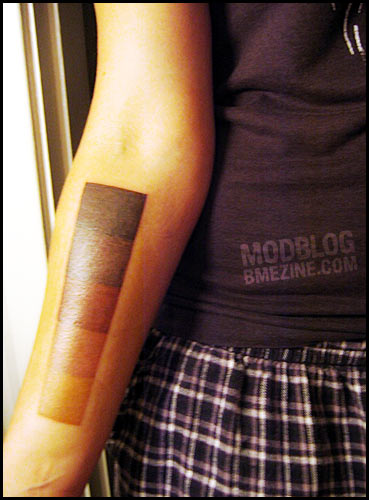
The quote is not from the wearer, but since we’re watching Survivor here tonight I thought it was appropriate. This is a McKenzie’s spectrum of skin tones (neat idea for a tattoo, I like it) done by Jason from Deep Roots in Seattle.

…according to the Davenport Tribune, December 15, 1893 that is!
It sure is a long lasting fad!
With the big number of railroad accidents which have marked the Columbian year there has been a widespread boom given to the art of the tattooer. There has been such a large percentage of unidentified dead among those killed in the smash-ups on the railroads of the country during the past few months that it has a remarkable effect on the travelling public. Men and women who a year ago would have shuddered at the mere suggestion of having the point of a tattooing needle touch their skin are having their names, monograms and even crests tattooed upon their bodies. And they all say that they have been tattooed in the belief that the marks made by the needle will be the best means for the identification of their bodies should they meet death away from their home and friends, says the Philadelphia Record.
But there is another class of people who, caught by the popular fad, are having emblems of secret societies and fraternities to which they belong, marked upon their skin. Many of the best known college men of the country carry the insignia of their fraternity worked upon their arms. It is among the drummers and members of the theatrical profession, however, that the tattoo man finds his greatest number of patrons. They spend a large portion of their lives in railroad cars; their danger from death in wrecks is greater than any other class of people, excepting railroad men, postal clerks and express messengers, and the tattooer is reaping a rich reward of coin from them.
With the spread of the tattooing fad in all parts of the United States the work with the ink and needle has been made well-nigh painless. The tattooing art has kept step with the march of progress in other directions and a brand-new method of puncturing the skin has taken place of the old. Instead of the laborious work of early days an electric tattoo machine has been invented. Where it required an hour in the old-fashion way to tattoo a name or a figure, the electric machine does it in a few minutes. The inventor of the machine is in the city, and lately he chatted interestingly of tattooing in general and the prevalent craze in particular. He is Professor O’Riley, probably the best known tattooer in either the United States or Great Britain. Many of the most noted tattooed men and women who have been on exhibition on both sides of the Atlantic are examples of his skill.
“I have tattooed thousands of persons, both in this country and England,” he said, “but at present the craze exceeds anything I have ever experienced during the last twenty years. Most people believe that only sailors and a vulgar class in general have tattoo marks put upon them. That is true in many instances, but by far the largest number of those that I am tattooing now are men and women of intelligence and refinement. The only explanation that I can make for this is that the danger of being buried among the unknown dead in case of a railroad, steamboat or other accident has been so strangely emphasized during the past year that men and women who travel much very wisely have the needles and ink place sure identification marks upon their bodies.
“Many of those tattooed, the ladies especially, have the work done with artistic surroundings. Men, generally want to be tattooed on the arms, while the women almost invariable have the decoration placed on the lower limb. I recently tattooed a serpent in brilliant colors around the leg of one of the best known comic opera prima donnas of the country. It bears her name in delicate letters. Another popular actress had me place a garter in vivid hues below the knee of her left leg and tattoo upon it ‘Tom,’ the name of her sweetheart, and one of the most prominent juvenile men in the profession.
“I tattooed the insignia of Delta Kappa Epsilon, one of the strongest of college fraternities, upon the arm of almost every member of the society. George Gould is one of the young men upon whose arm I place the symbol of the fraternity.
“Almost every day I put secret society marks on the arms of patrons. Two months ago I was surprised by a call from a tramp. He wanted a peculiar mark by which he was known to knights of the road tattooed in the palm of his right hand.”
I wonder… if Professor Riley could see the world today, would he me amazed, or bored?
I don’t know if the person who’s been spreading the good word wants to be outed; if you do, feel free to post in the forum. But I do have some ModCon news and I figured that this was as good a picture as any to post it with! ModCon V (which was originally planned for Venezuela, but we had to back off because of changes to Venezuelan law) will take place in Toronto in late March 2007. I’ll post full details in a week or two.

Jon tells me that the only reason that people do ass suspensions is because afterwards you’re guaranteed a sweet ass massage. Seems like a lot of effort to me. Thanks to MUTE-ONE from NU ETHIX SUSPENSIONS LLC (and Cutthroat Tattoo) in Wilwaukee, WI for these shots of a well balanced example.
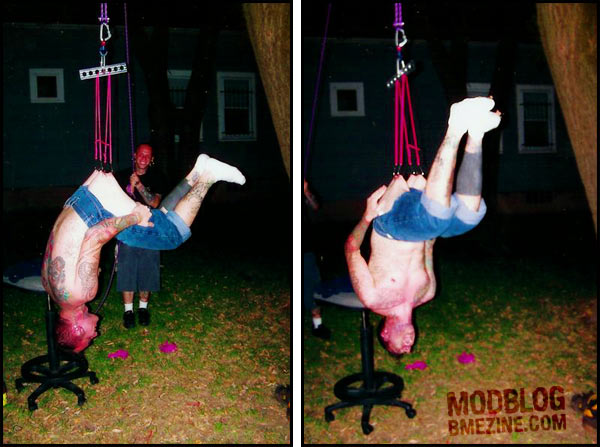
I’ve been meaning for some time to share with you this sort of misogynist tattoo on my old friend Ed Gein Dr.Scorpio (regulars may remember his Frank Zappa tattoo). This rib tattoo (in progress still) was done by Tony Browning at State of the Art in Sinchester, VA. I don’t know if he’s is messing with me about the city name?
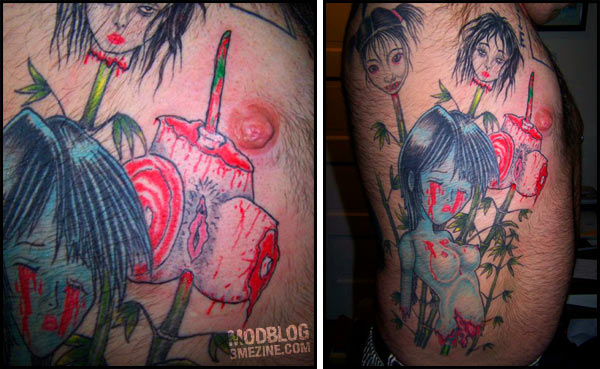
One of my favorite people in the entire world, a former teacher and man who’s a happy modern Great Omi (he writes, “A Smile is Worth So Much More Than a Frown”), is Tribalface in Durango, Colorado. Seriously, I just get so happy every time I see his picture. It’s amazing that something as simple as seeing a happy, well-adjusted, heavily tattooed guy can bring me such smiles.
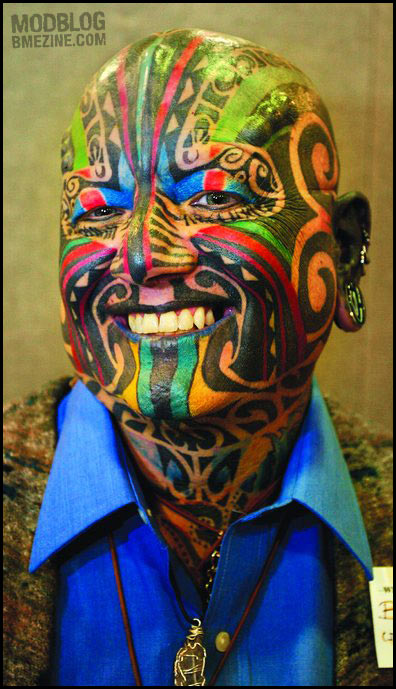
Love the implants too!
I’m surprised I don’t see more comic strip armbands — they really work nicely. This example on fellow Torontonian Pantopon Rose, tattooed by Dan Innes at Stingers in Newmarket, Ontario (Canada), is based on original art by Archer Prewit from his Sof’Boy Comic.
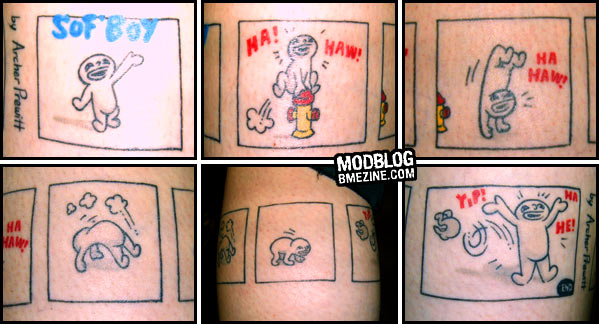
Please note that links may expire. IAM members, please help out by submitting stories!
I wanted to share one more wonderful photo from a recent forest suspension by the folks at Exiting Body Piercing in France.
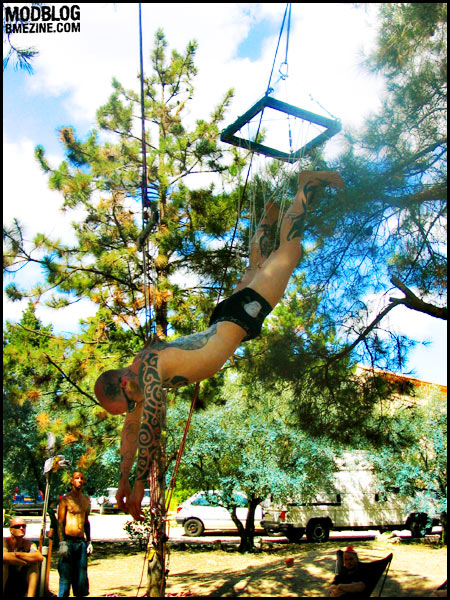
Sometimes it’s hard to track down the original source of an article because until relatively recently, we didn’t have draconian copyright laws, and newspapers regularly copied each other. This one comes from The Washington Post (November 4, 1885), and they say they got it from “a New York Paper”, and I suspect that newspaper took it from a Boston-based one. Anyway, let’s begin:
“Some Remarkable Stories by a Meek and Lowly Bostonian.”
Boston, Oct. 16— Just beyond the Mission building the eye of the seeker after novelties is attracted by this sign, upon cardboard:
TATTOOING DONE HERE.
It is a tiny shop, wedged between two loftier buildings. A door and one broad window, shaded by a scarlet curtain, comprises the entire front. Within, a rear apartment is formed by a curtain composed of the Stars and Stripes. The furniture is plain and simple. The occupant is a young man with a pleasant face. His arms are bared to the elbows, and bear evidence of his skill in a variety of figures, patriotic, mythological, and miscellaneous, “All I can well attend to,” said Mr. Getchell, the artist, when asked whether the demand for his labor is large. “You would be surprised to know how many difference classes of people call upon me to have tattooing done.”
“Sailors and boys chiefly,” was suggested.
“I have a great many of them, of course, but I cannot say that they are my chief customers. I tattoo a great many commercial travelers, who wish a small mark upon their bodies in case of accident. Then ladies and children form a large proportion of my customers. A great many parents bring their children to be marked for identification in case of loss or kidnapping. Children I almost invariably mark on the left leg, just above the ankle. I usually put on some small distinguishing mark, such as a star, an anchor, a strawberry or often a simple dot.”
“Is the process painful?” was asked.
“By no means. The design is first drawn on the skin in India ink, or vermillion; then it is lightly pricked in with needles. The other day a gentleman came in, bringing two little twin boys, about a year and a half old. They were dressed just alike, and they were as similar in every respect as two white beans.
“‘I want one of these chaps marked, so I can tell them apart,’ said the father.
“‘Don’t they know their names?’ I asked.
“‘If they do they both answer to the same name. If I call “Johnnie” they both answer, or if I call “Willie” they both answer, too. That breaks me all up, and I want one of them marked, so I can tell one from the other. I don’t care which one of them you take, only mark one of the quick.’
“So I took one of the little chaps on my knee and pricked a little dot on his left hand, on the space between the thumb and first finger. The boy looked on with great wonderment, but didn’t utter a cry, and went off with his father, looking at his hand.”
“You have many lady customers, you say?”
“Yes, a great many. I had a call from a woman once, who wished to be tattooed from head to foot for exhibition purposes, but I refused to do it. I frequently have calls from ladies who wish some small mark for the purpose of identification in case of accident. Often they dislike to have a mark put upon the arm, especially society ladies. In such cases I frequently mark the shoulder, where the mark will be concealed, even when in full dress. But I have very frequently put the initials, and sometimes the full name, upon the fleshy part of the upper arm.”
“It is said that ladies often have the initials or monograms of their lovers placed upon their arms?” was suggested.
“Oh, frequently! They come in their carriages and have it done. Once I put the words ‘Dear Harry’ on a young lady’s arm.”
“Do they ever come afterward and wish it erased or changed?”
“Oh, often. I had a curious case once. A very pretty and stylish young lady came here in a Herdic cab. She said she had left her carriage standing near the Public Garden and had taken the Herdic to avoid notice. She wanted the initial ‘P’ in a fancy letter placed upon the top of her shoulder.
“‘You see,’ she explained, ‘P stands for Paul, the—the gentleman whom I—I am to marry. I don’t want it where it will show, of course; but put it just where the shoulder band will cover it when I am in full dress. Make it blue, shaded with red.’
“She screamed a little when the needle made the first price, but she soon discovered that the pain was insignificant, and the work was soon done to her satisfaction.
“‘How pleased he will be,’ she said, when it was over. ‘But he shan’t see it until after we are married,’ she added, as she went out.
“A few months afterward a Herdic stopped at the door, and the same lady alighted and entered. ‘You see,’ she explained, with a very slight blush, ‘that the gentleman whose initial you put on my shoulder doesn’t—doesn’t come any more, and I want it changed. Do you think—do you think you could change it to a B?’
“‘Oh, yes,’ said I; ‘that can be done very easily.’
“‘You see, this gentleman’s name is Bashford, and I thought you could change it easily.’
“So I changed the P to a B, and put on a few flourishes, and she left. I thought I had seen the last of her, until a few months ago she came again, and blushed in earnest.
“‘Well,’ said I laughing, ‘must I change it again? What is his name now?’
“‘His name is Mortimer, and oh, we are to be married next week and my dress and veil are all done and I am afraid of making him angry, for he knows nothing of the others. Do you think you could change the B to an M.’
“‘That would be impossible,’ said I, ‘but I can cover the latter over with some other design if you like that.’
“‘No, I shouldn’t like that. It wouldn’t mean anything,’ she said, looking almost ready to cry. Then suddenly she looked up and cried out: ‘Oh, I have it. I just done on Beethoven and so does he. I’ll let the B stand for Beethoven and you shall put on the first two measures of his sonata in A minor. Won’t that be nice?’
“Seizing a pencil, she marked a staff and a few notes of music on a scrap of paper, and handed it to me. I sketched on her shoulder a scroll bearing the initial B in the center, and then drew in the staff and notes as she had indicated. It was quite a nice job, but she was very patient, and finally went away smiling and humming the air which I had tattooed on her shoulder.”
“Did you ever see her again?”
“A few days later I chanced to be in the Boston and Albany Depot, when a lady and gentleman passed me, going toward the train. She had the look of a bride, and as they passed me she gave me a glance and hummed the air that I had scratched upon her shoulder.”
I don’t know about you, but this is one of my favorite old tattoo stories I’ve dug up yet…